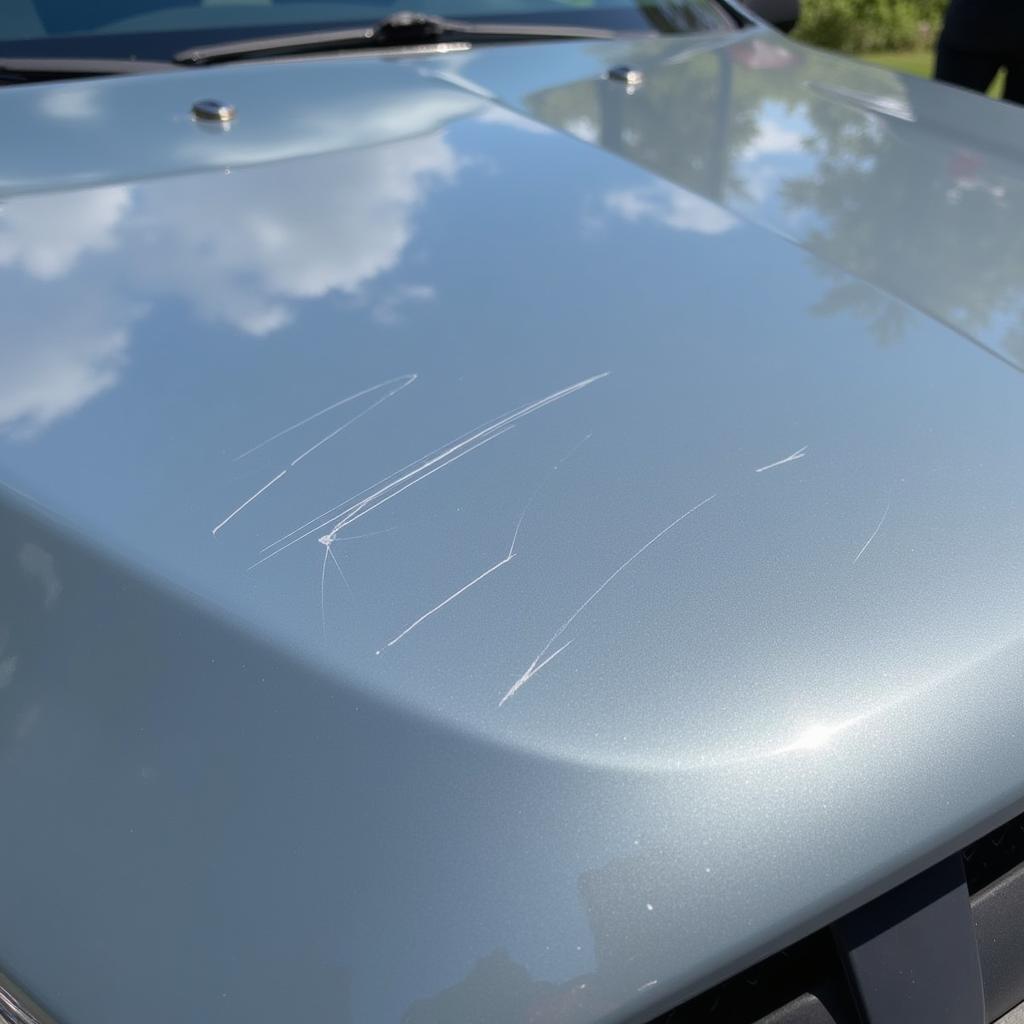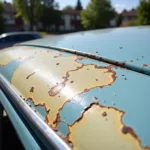Scratched car paint is an unfortunate reality for many car owners. Whether it’s a minor scrape from a shopping cart or a deeper gouge from a rogue key, knowing how to repair scratched car paint can save you money and keep your car looking its best. This guide will walk you through various methods for fixing those unsightly blemishes, from simple DIY solutions to more professional approaches.
Identifying the Scratch: Light vs. Deep
Before you begin any repairs, it’s crucial to assess the damage. How deep is the scratch? A light scratch that only affects the clear coat is much easier to fix than one that penetrates the paint and reaches the primer or bare metal.
Light Scratches: Clear Coat Only
These scratches are often barely visible and feel smooth to the touch. They can usually be remedied with polishing or rubbing compounds.
Moderate Scratches: Reached the Paint
These are more visible and you can often feel the groove with your fingernail. Repairing these typically involves touch-up paint and some polishing.
Deep Scratches: Primer or Metal Exposed
These are serious scratches that expose the underlying layers. They require more extensive repair, often involving sanding, priming, and painting.
DIY Repair Methods for Light and Moderate Scratches
For light to moderate scratches, you can often handle the repair yourself with a few readily available products.
Washing and Drying: The Essential First Step
Thoroughly wash and dry the affected area to remove any dirt or debris that could further scratch the paint during the repair process. This ensures a clean surface for the repair products to adhere to.
Using a Rubbing Compound
For light scratches, a rubbing compound can be very effective. Apply a small amount to a clean microfiber cloth and rub it onto the scratch using gentle, circular motions. Buff off the excess with a clean cloth.
Touch-Up Paint for Moderate Scratches
If the scratch has reached the paint layer, you’ll need touch-up paint. Choose a paint that matches your car’s color precisely. Apply a small amount to the scratch, letting it dry completely before lightly sanding and polishing the area.
When to Call a Professional
While DIY methods are suitable for minor scratches, deeper scratches require professional attention. If the scratch has reached the primer or bare metal, it’s best to leave it to the experts.
Deep Scratch Repair: A Multi-Stage Process
Repairing deep scratches involves sanding down the damaged area, applying primer, painting, and finally, blending and polishing the new paint to match the surrounding area seamlessly.
“Deep scratches can lead to rust if left untreated,” says John Smith, Senior Automotive Technician at Smith Auto Body. “Professional repair ensures the integrity of the paint and protects your car from further damage.”
Preventing Future Scratches
Protecting your car’s paint is always the best strategy. Here are a few tips:
- Regular Washing and Waxing: This helps protect the clear coat and prevents minor scratches.
- Covered Parking: Parking in a garage or under a carport shields your car from the elements and reduces the risk of scratches.
- Careful Parking: Avoid parking too close to other cars or in areas with high pedestrian traffic.
Conclusion
Repairing scratched car paint, whether a minor blemish or a deeper gouge, can significantly enhance your car’s appearance and value. By understanding the different types of scratches and the appropriate repair methods, you can effectively address these issues and keep your car looking its best. Remember, for deep scratches or if you’re unsure about tackling the repair yourself, consulting a professional is always the best approach. How to repair scratched car paint becomes manageable with the right information and approach.
FAQ
- Can I use toothpaste to remove car scratches? (While toothpaste can sometimes minimize the appearance of very superficial scratches, it’s not a recommended solution for anything beyond the slightest blemish.)
- What is the best way to remove key scratches from a car? (The best approach depends on the depth of the scratch. Light key scratches can sometimes be addressed with polishing compounds, but deeper scratches require professional repair.)
- How much does it cost to repair a scratched car bumper? (The cost varies depending on the severity of the damage and the type of repair needed. It’s best to get a quote from a reputable auto body shop.)
- How long does touch-up paint take to dry? (Drying time varies depending on the product and environmental conditions, but it typically takes a few hours to dry completely.)
- Can I wax my car after repairing a scratch? (Yes, waxing your car after the repair is complete and the area is fully cured will help protect the repaired area and blend it with the surrounding paint.)
- What is the difference between a rubbing compound and a polishing compound? (Rubbing compound is more abrasive and is used to remove deeper scratches, while polishing compound is finer and is used to restore shine and remove minor imperfections.)
- How can I prevent swirl marks when polishing my car? (Use high-quality microfiber cloths and apply the polishing compound using light, even pressure. Avoid excessive rubbing.)
“Prevention is always better than cure,” advises Maria Garcia, Automotive Paint Specialist at Garcia Auto Detailing. “Regular maintenance and careful parking habits can significantly reduce the risk of scratches and keep your car’s paint in pristine condition.”
For further assistance with car repair and diagnostics, explore our other helpful articles on CarRepairOnline. We offer detailed guides and expert advice on a wide range of automotive topics.
Need expert help? Contact us via WhatsApp: +1(641)206-8880, or Email: [email protected]. Our customer support team is available 24/7.



